Cellulose vs. Fiberglass Insulation | Koala Insulation of West Florida

Cellulose vs. Fiberglass Insulation
Insulation is essential to help protect your home from outside weather and keep your energy bill from skyrocketing. But not all insulation materials are equal.
Each insulation type has its own set of benefits and disadvantages that affect whether it'll fit well with your home. Finding the insulation material that best suits you and your family's unique needs can make all the difference in creating a safe and comfortable home environment.
To help you figure out which insulation product is best for you, we will be comparing cellulose vs. fiberglass insulation.
The Basics of Fiberglass Insulation
If you've seen pink, cloud-like material in attics before, this is not an industrial form of cotton candy—this is traditional fiberglass insulation. Fiberglass is one of the most popular insulations, and for a good reason. It's a low-cost but effective way of regulating the temperature in your home.
But what is fiberglass exactly?
Fiberglass is made of tiny pieces of mostly recycled material such as melted-down glass, combined with other materials like sand and limestone and then woven into long strands, giving it a cotton-like appearance.
Fiberglass comes in many different forms, but batts and loose-fill fiberglass are the most commonly used for home insulation.
Fiberglass Batts
Batts is made up of large rolled-up sheets of fiberglass held together by either aluminum foil or adhesive paper.
Batts is used more frequently as the form of fiberglass insulation in homes because they make installation quick and convenient. The product is designed to fit between standard-sized joists, which means all you need to do to install them is to unroll them and then attach them.
However, one downside to this type of insulation is that it's difficult to customize these pre-made rolls to fit different shapes. This property makes it hard to install in attics with pipes or other obstructions between joists.
That's where loose-fill fiberglass comes in.
Loose-fill Fiberglass
Like batts, loose-fill fiberglass is also made up of tiny, recycled glass fibers. Instead of being woven into long blankets, they're cut into small pieces, which are then blown into place using an insulation-blowing machine.
Loose-fill insulation allows people who cannot get batts installed in their attic due to obstructions or other reasons to enjoy the benefits of fiberglass insulation still.
Pros and Cons of Fiberglass
Fiberglass is a popular choice among homeowners and attic professionals alike. One of the many reasons is that fiberglass has many upsides and only a few downsides.
Advantages of fiberglass include:
- Cost-Effective – Not only is fiberglass made up of a relatively low-cost material, but it's also such an effective insulator that it can help decrease your energy bill by 40%, helping you save money in the long run.
- Long-Lasting – Fiberglass is highly durable and can last up to 100 years in ideal conditions. Unlike other insulation materials, it also doesn't shrink over time.
- Non-Flammable & Moisture-Resistant – Though fiberglass may look like cotton, it's primarily made up of glass, which means there's a much lower risk of it catching fire or developing moisture-related problems in humid weather.
- Noise Insulation – Fiberglass is an extremely effective insulator when protecting your home against the weather and unwanted noise. Whether you live in a busy part of town with lots of traffic or have a loud generator right outside, fiberglass insulation can help keep your home quieter and more peaceful.
Disadvantages of fiberglass include:
- Ineffective When Wet – If your fiberglass becomes significantly wet due to a leak in your attic, the insulation will not work effectively until professionally dried.
- Self-Installation Can Be Dangerous – Because fiberglass is made up of tiny glass fragments, it can be dangerous to handle it without taking safety precautions, and improper handling can lead to health problems like rashes or respiratory damage. That's why it's always best to consult an expert while installing fiberglass insulation.
What is Cellulose Insulation?
Cellulose is another popular form of home insulation. The product is made from 82-85% recycled material like newspaper or tiny wood fragments. These are shredded and fiberized to be able to pack tightly together and stop the flow of heat.
While there is only one type of cellulose insulation, there are several different ways to install it.
Old Home Installation (Blown Dry)
For homes with a pre-existing structure, part of the siding will need to be removed, a row of holes will be drilled into the wall, and then insulation can be blown in dry.
New Home Installation
- Damp-sprayed – Moisture is added to the tip of an insulation spray nozzle, activating the starch in the cellulose. It's then sprayed over the cavities in your home.
- Dry-netting – A net is blown full of dry cellulose and then stapled over openings in the building.
The best method of cellulose insulation installation will depend on what kind of home you have and what tools are available to you.
Pros and Cons of Cellulose
While there are certain advantages of having paper-based insulation, there are also some notable disadvantages.
Advantages of cellulose include:
- Low-price – Because cellulose is primarily made from paper, it's an even more inexpensive form of insulation at about 75% of the cost of fiberglass.
- Easy Installation – Cellulose comes in small pieces. There are many ways to install it, so it fits well with most homes' structures but can be very messy to install.
Disadvantages of fiberglass include:
- Not Pest Repellant – Since cellulose is not naturally pest repellant, it's often treated with chemicals like boric acid that claim to ward off rodents and bugs. Boric acid does little to repel rodents, leaving your home vulnerable to a potential infestation.
- Naturally Flammable – Cellulose is also treated with chemicals to help make it more flame resistant. Still, it's made of paper, and it will always pose more of a fire risk than a non-flammable insulation material.
- Settles After Installation – Cellulose insulation tends to settle by several inches after it's installed, which causes it to decrease in effectiveness.
- Mold Grows When Wet – Like fiberglass, cellulose is ineffective when wet, but it can also be dangerous, unlike fiberglass. The cellulose paper base provides the perfect environment for mold and mildews to grow, and the boric acid used to treat it can become corrosive when in contact with water.
- Excess Dust – Because cellulose is essentially made of finely shredded paper, it creates much dust when installed, making it difficult to clean up and can turn it into a breathing hazard for those installing it.
R-Value: The Role of Thermal Resistance
One of the most important considerations when comparing different types of insulation is R-value. R-value measures the thermal resistance of a material, or in other words, its ability to keep warm places warm and cold areas cold.
Materials with a higher R-value will more effectively insulate your home, helping you keep a more regulated temperature indoors and a lower energy bill.
Different insulation materials have different ways of combating heat flow and, therefore, different R-values. Fiberglass' R-value ranges between 2.2 and 4.3 depending on the material density, whereas cellulose's R-value ranges between 3.2 and 3.5.
Cellulose insulation has a slightly higher average R-value than fiberglass, but high-quality fiberglass provides better thermal resistance than high-quality cellulose.
Should I Choose Fiberglass or Cellulose Insulation?
While both fiberglass and cellulose insulation have their benefits and can be helpful in different environments, overall, fiberglass has much more advantages than its downsides.
Fiberglass installation is an affordable, easy-to-install form of insulation compatible with most homes and protects against a lot of the dangers caused by poor insulation materials.
Because of this, we recommend fiberglass over cellulose for high-quality insulation that will last.
Koala Insulation of West Florida: The Experts in Home & Attic Insulation
Koala Insulation of West Florida is here to help with all your home's fiberglass insulation needs. Koala Insulation of West Florida is the leading expert in home attic insulation installation in the West Florida area.
If you're not sure where to get started, we offer free insulation consultations to help answer any questions you may have about your home's insulation. When you request a virtual consultation, you'll meet with one of our professional contractors to thoroughly inspect your home's insulation situation and get a quote on insulation cost.
Visit our website today to sign up for a virtual consultation and start living more comfortably in your home.
Find Your Location


Get a quote



